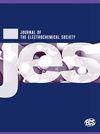An Ultrasensitive Glypican‑3 Electrochemical Aptasensor Based on Reduced Graphene Oxide-Carboxymethylchitosan-Hemin/Palladium Nanoparticles
IF 3.3
4区 工程技术
Q2 ELECTROCHEMISTRY
引用次数: 1
Abstract
Glypican-3 (GPC3) is a serum marker for hepatocellular carcinoma (HCC) and has excellent specificity and sensitivity. Herein, the construction of an electrochemical aptasensor based on reduced graphene oxide-carboxymethyl chitosan-hemin-palladium nanoparticles (RGO-CMCS-Hemin/Pd NPs) and GPC3 aptamer (GPC3apt) has the function of GPC3 identification and analysis. RGO-CMCS-Hemin/Pd NPs has excellent biocompatibility, large specific surface area, and good electrical conductivity, which is not only useful as an advanced sensing material to modify the electrode surface to reduce the resistance and increase the signal amplitude, but also used as an electroactive substance to provide electrical signals. GPC3apt as a biometric element gives the aptasensor good specificity and sensitivity. The GPC3apt can combine with GPC3 and form GPC3-aptamer conjugation, which increases the electron transfer impedance and changes the electrical signal. Under optimum conditions, the aptasensor had a good linear relationship with the GPC3 concentration in the range of 1.0-100.0 ng/mL with R2 of 0.9573. The lower limit of detection was 1.0 ng/mL. When the aptasensor was applied to GPC3 detection in human serum samples, the recovery was 93.73%-118.83%. In addition, the GPC3 aptasensor has excellent specificity, reproducibility, and stability, which can be applied in the clinical detection of GPC3.基于还原氧化石墨烯-羧甲基壳聚糖-血红素/钯纳米粒子的超灵敏Glypian‑3电化学适体传感器
Glypian-3(GPC3)是肝细胞癌(HCC)的血清标志物,具有良好的特异性和敏感性。本文构建了一种基于还原氧化石墨烯羧甲基壳聚糖血红素钯纳米粒子(RGO-CMCS-hemin/Pd NPs)和GPC3适体(GPC3apt)的电化学适体传感器,具有GPC3鉴定和分析功能。RGO CMCS Hemin/Pd NPs具有优异的生物相容性、大的比表面积和良好的导电性,不仅可以作为一种先进的传感材料对电极表面进行修饰,以降低电阻和增加信号幅度,还可以作为电活性物质提供电信号。GPC3apt作为一种生物识别元件,使适体传感器具有良好的特异性和敏感性。GPC3apt可以与GPC3结合,形成GPC3适体偶联,这增加了电子转移阻抗并改变了电信号。在最佳条件下,适体传感器与GPC3浓度在1.0-100.0ng/mL范围内具有良好的线性关系,R2为0.9573。检测下限为1.0 ng/mL。将该适体传感器应用于人血清样品中GPC3的检测,回收率为93.73%-118.83%。此外,GPC3适体传感器具有良好的特异性、重现性和稳定性,可用于GPC3的临床检测。
本文章由计算机程序翻译,如有差异,请以英文原文为准。
求助全文
约1分钟内获得全文
求助全文
来源期刊
CiteScore
7.20
自引率
12.80%
发文量
1369
审稿时长
1.5 months
期刊介绍:
The Journal of The Electrochemical Society (JES) is the leader in the field of solid-state and electrochemical science and technology. This peer-reviewed journal publishes an average of 450 pages of 70 articles each month. Articles are posted online, with a monthly paper edition following electronic publication. The ECS membership benefits package includes access to the electronic edition of this journal.

 求助内容:
求助内容: 应助结果提醒方式:
应助结果提醒方式:


